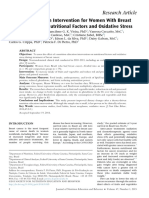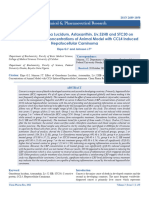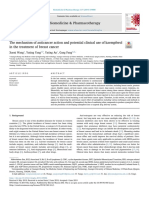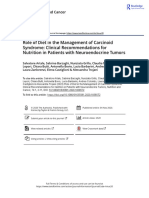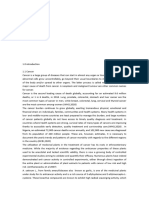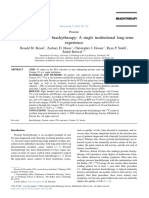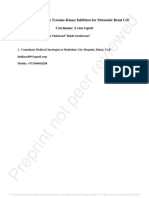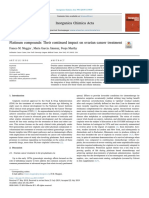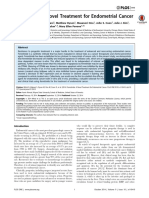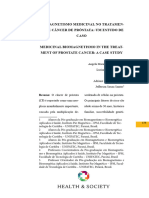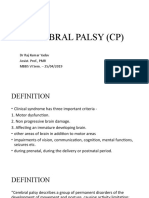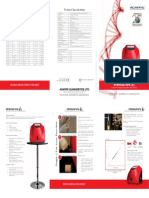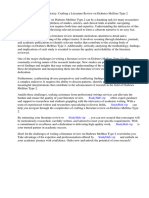Prostate Cancer Nardi
Prostate Cancer Nardi
Uploaded by
Jason NardiCopyright:
Available Formats
Prostate Cancer Nardi
Prostate Cancer Nardi
Uploaded by
Jason NardiOriginal Title
Copyright
Available Formats
Share this document
Did you find this document useful?
Is this content inappropriate?
Copyright:
Available Formats
Prostate Cancer Nardi
Prostate Cancer Nardi
Uploaded by
Jason NardiCopyright:
Available Formats
C^O^N^T^E^N^T^S
CALENDAR OF EVENTS.................................................. 119
DABCI SCHEDULE/7WZZ.4, MISSOURI........................ 120
DABCI SCHEDULE/T(7ZA4, OKLAHOMA .....................121
FROM THE EDITOR'S DESK .........................................122
Virginia Kes singer
THE CLINICAL IMPORTANCE OF VITAMIN D
(CHOLECALCIFEROL)
A PARADIGM SHIFT WITH IMPLICATIONS FOR ALL
^K4ZT^C47?£TP2?OF72)^^^......................................................................124
Alex Vasquez, DC, ND
Gilbert Manso, MD
John Cannell, MD
RESOLUTION OF PROSTATE CANCER AFTER
NUTRITIONAL PROTOCOLS AND LIFESTYLE
MODIFICATIONS:
^C4^£'^T£72)y.............................................................................................l38
Jason Nardi, DC, DABCI, DACBN, FIAMA
THOUGHTS AT LARGE: Issue 18
CONTROVERSIES IN CLINICAL NUTRITION
AND FUNCTIONAL MEDICINE
A NUTRITIONAL SUPPORT FOR CANCER PATIENTS........................ 148
Jeffrey Moss, DDS, CNS, DACBN
DABCIs AND WHERE THEY ARE........................................................... 155
CLINTPUBLICA TIONS
VOL. 26, N0.4 • ISSN 1529-4722 • DECEMBER 2020
tious prostatitis and prostate cancer has long been sus
Resolution ofProstate pected. Systemic and localized applications of botani
cal agents showed benefits, while PSA remained ele
_
Cancer after Nutritional vated. The use of botanicals in prostate adenocarcmo
mas warrants further investigation.
Protocols & Lifestyle Introduction:
Prostate cancer is the second leading cause of death in
Modifications: A Case Study American males and the most common cancer. Accord
ing to recent figures, 1 in 9 men will be diagnosed with
prostate cancer during his lifetime with an estimated
164,690 new cases th.is year with an estimated 29,430 1
by: Jason Nardi, DC, DABCI,, DACBN, FIAMA. deaths. The most prevalent risk factors are age and
race·2 Other factors include diet, tobacco use, alcohol
consumption, low physical activity and exposure to
Keywo rds: Prostate Cancer; Remission Induction; environmental contaminants.3 Data also supports past
Clinical Nutrition; Food Habits; Lifestyle Factors prostatitis and infections have a strong link to future
prostate cancer.4·5
Abstract:
Introduction: The presented case focused on a 71 year-old Caucasian
This case study focused on the use of lifestyle, diet and male with prostate cancer confirmed with a needle bi
nutritional supplementation to support the treatment of opsy, who presented for nutritional support before tra
prostate adenocarcinoma. ditional treatment. Suppo1t included oral zinc, vitamin
C (VC), and vitamin K 1 and K2, as MK.7 (VK) supple
Case Presentation: mentation and botanical agents.
The subject was a 72 year-old male recently diagnosed
with prostate cancer con. firmed with a 12-needle biopsy Clinical History:
by his urologist. History was positive for past prostati The patient a 71 year-old Caucasian retiree. His social
tis, benign prostatic hypertrophy and environmental and work history included tobacco use at the age of ten
exposure associated with prostate carcinoma. until 22 and exposme to petrochemicals as an auto me
chanic. The subject worked at a family-owned nursery
Management & Outcome: and greenhouse but does not remember using chemical
Serological inflammatory and immunological markers fertilizers or pesticides. He also reported a history of
were high. Focus was on the use of botanicals with hematospermia eight years before the diagnosis of
high flavonoid and polyphenol content to help support prostate cancer; Hematospennia is associated with
the immune system to reduce inflammatory pathways. chronic prostatitis. 6
Dietary restrictions and lifestyle modifications were
implemented to also lower inflammation. Vitamin ther The patient had increasing PSA lab values from 3.8ng/
apy using oral vitamin C in combination with vitamin mL to 4.2ng/mL and was sent by his PCP to a urologist
K as an anti-cancer method. This combination has long in January 2018, who confirmed with a surgical biopsy
been thought to have benefits in preventing neoplastic of 12 specimens in March 2018. Biopsy results showed
activity. prostatic adenocarcinoma in the left apex with a Glea
son Score of 6 (3+3) 7consisting of IO¾ of needle core
After six months of following protocols, blood markers tissue. Using the ISUPS grading, this amounts to a
were mostly improved and imaging showed no cancer prognostic grade group 1.8 After being told tr_eatm�nt
present in the prostate. would be determined with follow-up labs and unagmg
that would be scheduled in July and August, respec
Di scussion: tively, the subject sought immediate alternative treat
While the use of vitamin C and vitamin K is currently ment methods for the interim.
being used as an adjunct to traditional prostate cancer
treatment as Apatone®, oral supplementation in the Discussion:
same ratio may have equal benefit. This case also Alternative treatment began with simple dietary
showed there may be evidence that botanical support changes to cut down on and eliminate inflammatory
and vitamin therapy may be a viable vehicle in battling foods. Processed meats were removed due to the high
prostate carcinomas. The association between infec-
(Continued on page 140)
THE ORIGINA l lNTERNJST
M
DECEBER 2020 138
association in raising overall cancer risks, and red In one study, zinc levels were examined in several
meats were replaced with grass-fed versions to help groups of men with prostate issues: In prostate carci-
increase Omega 3 intake, especially conjugated linoleic noma, zinc levels were decreased by 83%, and in BPH
acid (CLA), due to its anticarcinogenic effect. there was a 61% decrease in tissue link levels com-
Other modifications were to increase activities to in- pared to normal tissues.
elude 20 minutes or more of walking, increase water
intake to 2-3 quarts daily, and replace coffee with green Additionally, Biocidin® capsules were used as a
tea.12 nightly rectal suppository to help with possible infec-
tious causes of prostatitis. Initial laboratory analysis
Initial Phase: showed increases in both lymphocytes and monocytes,
The initial 30-day phase of care included nutritional with normal white blood cell counts (Figure 1). Bio-
supplementation aimed at promoting clearance in the cidin® was chosen for its ingredient content (Figure 2),
body using botanicals that also contained anticarcino- especially bilberry; because it was in capsules that
genie properties. A product containing 50 mg each of could be delivered more locally as a suppository. The
Milk Thistle,13 turmeric,14 artichoke,15'16schisandra,17 most common infectious agents in the prostatitis are
rosemary,18'19 dandelion,20'2' yellow dock,22 gentian,23 Escherichia coli, Klebsiella, Proteus, Pseudomonas,
and barberry was used. Dosing was 50 mg of each, Enterobacter, Enterococcus, Serratia, and Staphylo-
combined in a capsule taken twice daily. Polyphenol coccus aiireus, all of which rely on efflux pumps to get
intake from these botanicals showed promise in fight- rid of toxic substances, including antibiotics. Inhibiting
ing cancerous cells; polyphenols' anti-carcinogenic efflux pump activity is shown to reduce biofilm forma-
properties include inhibitory effects on cancer cell pro- tion.3 Bilberry, or Vaccinium myrtilhis L., contains the
liferation, tumor growth, angiogenesis, metastasis, and polyphenol proanthocyanidin that has been shown to
inflammation, and help induce apoptosis.25'2 Polyphe- prevent bacterial adhesion.
nols have shown promise in targeting signal transduc-
tion pathways involved in carcinogenesis and reduces Vitamin K (VK) has been well known to have antioxi-
NF-kB mediated pathways, reducing inflammation as- dant effects on cancer, however recent studies are
sociated with tumor cells; Up-regulation of NF-kB in showing that VK and its analogs have additional effects
tumors cells inhibits apoptosis, increases angiogenesis on cancer, including apoptosis, cell cycle arrest, auto-
and metastatic capacity of tumor cells.27'28 Enzymatic phagy and modulation of various transcription fac-
and antioxidative properties of flavonoids add to their tors.34 It has long been suspected that VK combined
effectiveness; Antioxidative effects of flavonoids in- with vitamin C (VC) would be effective in treating can-
duce enzyme deactivation of free radicals and reactive cer. Tareen, et. al. showed that VC and VK as Apa-
oxygen species (ROS) and prevent them from becom- tone® were effective in delaying the progression of
mg mutagens/ advanced prostate cancer in 17 patients who did not
respond to standard therapy. While VC has been shown
Second Phase: to be an effective anti-oxidant and is shown to reduce
Compliance with suggestions was good after the initial chromosomal damage, thus reducing neoplasm activity.
30 days. While dietary restrictions and lifestyle modifi- Taper et al. demonstrated that VC inhibited the growth
cations did not change after the initial 30 days, new of both androgen-dependent and androgen-independent
nutritional support was implemented. This phase of human prostate carcinoma cells in mouse models. Dos-
care was focused on concepts that would arrest and ing for this phase was Apatone® of 100:1 VC to VK;
lower inflammation in the prostate and help support 6,000 mg ofVC was used with 620 mcg ofVK.
anticancer pathways.
Results:
With ample indicators of prostatitis, a large focus was The subject remained compliant with care after four
on reducing inflammation. It is well known that copper months of the above dietary and lifestyle modifications,
has a proclivity for prostate tissue. Copper is readily and nutritional supplementation. A new PSA lab was
leached from pipes used for plumbing in the US and taken in July; though still elevated at 5.2 ng/mL, this
can at times exceed safe levels, depending on the tem- would be within normal for a patient of this age.38 One
perature of the water, mineral content, the age of the month after the PSA lab multiplanar magnetic reso-
plumbing and how long water has been standing in the nance images of the pelvis were obtained using Gadav-
plumbing. To remove suspected copper from the pa- ist IV contrast. Clinical findings were: post obstmctive
tient, 60 mg of zinc picolinate was given daily. Some hypertrophy of the bladder wall, most likely due to
data shows that zinc is essential to good prostate health. BPH. The prostate measured 4.3 x 4.8 x 4.8 cm, with
(Continued on next page)
THE ORIGINAL INTERNIST DECEMBER 2020 140
an overall volume of 48 ec. This is considered specific functions in treatment; the use of polyphe-
enlarged39 and was elevated at the bladder base; there nols and flavonoids to reduce inflammatory signal-
was mild heterogeneity of peripheral zone without sig- ing pathways and cell proliferation, while inducing
nificant foci of diffusion restriction, or unusual vascu- apoptosis appears to be a good reason for their in-
larity on computer-aided postcontrast evaluation; The clusion.
prostate capsule was intact; The neurovascular bundle
appeared normal bilaterally. The overall impression While there is evidence that associates infection
was an enlarged prostate with BPH centrally. There with prostatitis and evidence that links prostatitis to
was no evidence of any suspicious lesion in the gland prostate carcinoma, the connection between infec-
and no evidence of extracapsular spread of a tumor. tious prostatitis and the prevalence of prostate can-
The treating medical doctor agreed and stated their im- cer has never been shidied in-depth. Localized appli-
pression overall was an enlarged prostate gland with cation of botanicals may prevent bacterial adhesion
benign prostatic hypertrophy. No suspicious lesions in and the reduction of biofilms which may be an ef-
the gland were noted and no evidence of any tumor. fective, low-cost solution to treat several prostate-
related disorders, most especially benign prostatic
Post-treatment suggestions were to continue with die- hypertrophy and prostatitis.
tary and lifestyle modifications and follow through
with the urologist's recommendations of annual PSA The use of VC and VK has long been thought to
and DRE. have antineoplastic effects. While the drug Apa-
tone® has been shown safe and is moving into ad-
Conclusion: vanced clinical studies, the use of oral VC and VK
There has been ample study in the use of nutrition, sup- supplementation is limited to case and small cohort
plementation, lifestyle and dietary changes being used studies, which warrant further investigation.
to help hinder neoplastic activity. There appears to be
Acknowledgments:
much overlap in the lifestyle changes having a benefit
This case would not have been a success without the
in different forms of cancer; from the removal of sugars
guidance of Dr. Delilah Renegar.
and high inflammatory foods to the addition of foods
Conflicts of Interest:
that support the body as a whole. Nutritional protocols,
The author declares that they do not have conflicts
on the other hand, should be aimed at supporting
of interest.
Figures & Charts
Figure 1: Initial and follow-up lab values
Element 3/31/2018 12/28/2018 Units Optimal Range Standard Range
Glucose 117.00 113.00 mg/dL 72.00-90.00 65.00-99.00
AlkPhos 51.00 59.00 IU/L 70-100 35-115
AST 36.00 26.00 IU/L 10.00-26.00 10.00-25.00
ALT 61.00 34.00 IU/L 10.00-26.00 6.00-29.00
Femtin 753.00 604.00 ng/mL 50.0-150.0 10.0-232.0
Hs CRP, Male 4.10 1.19 mg/L 0.00-0.99 0.00-2.90
WBC 5.40 5.20 k/cumm 5.30-7.50 3.80-10.80
RBC 4.86 4.56 m/cumm 4.20-4.90 4.20-5.80
Neutrophils 45.00 49.80 % 40.00-60.00 40.00-60.00
Lymphocytes 41.60
M;onocytes 11.00 11.00 % 0.00-7.00 0.00-7.00
Eosinophils 2.00 2.10 % 0.00-3.00 0.00-3.00
Basophils 0.40 0.40 % 0.00-1.00 0.00-1.00
(Continued on next page)
141 THE ORIGINAL INTERNIST DECEMBER 2020
Fignre2: Biocidin ingredients & actions
Ingredient Medicinal Action Reference
40.41.42
Bilberry Vaccinhim myrtillns Anti-inflammatory, antimicrobial, antioxidant, urinary antiseptic
41
Noni Morinda citrifolia Anti-inflammatory, antimicrobial, antioxidant
Antimicrobial, antioxidant, choleretic, hepatic trophorestorative, hepa-
40,42
Milk Thistle Silybiim marianum toprotective.
Echinacea pnrpnrea
Echinacea Anti-inflammatory, antifungal, antiviral, depurative,
41.42
Echinacea angiistifolia immune-enhancing, immune-modulating, lymphatic
Hydrastis Antibacterial, antihistamine, anti-inflammatory, antimicrobial, mucous
40.42
Golden Seal canadensis membrane, trophorestorative.
Shitake Lentimila
42
mushroom edodes Antibacterial, antifungal, antioxidant, iiTimune-modulating.
White willow
40
bark Salix alba Analgesic, anti-inflammatory.
40
Garlic Allium sativum Anthehnintic, anti-inflammatory, antimicrobial, antioxidant.
42
Grape Seed Vitis vinifera Antheknintic, anti-inflammatory, antioxidant.
40
Black Walnut Juglans nigra Anthelmintic, antimicrobial, depurative.
40.42
Raspberry Rubus idaens Anti-inflammatory, antimicrobial, antioxidant.
Fnmaria
40,42
Fumitory officinalis Antimicrobial, antioxidant
Gentian Genriana lntea Anti-inflammatory, antimicrobial, antioxidant.
Melalenca
44. 45,46
Tea Tree oil allernifolia Antifangal, antimicrobial.
Ferula
47
Galbanum oil galbaniflua Anti-inflammatory, antimicrobial, antiseptic.
Lavandiila
48
Lavender oil officinalis Antifungal, anti-mflammatory, antimicrobial.
Origanum
49
Oregano oil vulgare Antibacterial, antifungal, anti-inflanimatory
About the Author S.Pacheco SOS, Pacheco FJ, Zapata GMJ, et al. Food Hab-
Dr. Jason Nardi is a Board-Certifled Chiropractic Intermst
its, Lifestyle Factors, and Risk of Prostate Cancer in Central
and clinical nntritiomst and he holds a fellow in medical acu- Argentina: A Case Control Study Involving Self-Motivated
puncture. Dr. Nardi maintains a private practice in Jimean, Health Behavior Modifications after Diagnosis. Nutrients.
Alaska that focuses on neuro-strnctnral issues, pain condi- 2016;8(7):419.doi:10.3390/nu8070419.
tions, and digestive and hormonal health using a whole- 4Jiang J, Li J, Yunxia Z, Zhu H, Liu J, Pumill C. The Role
person, holistic approach. Dr. Nardi has a passion for ediica- of Prostatitis in Prostate Cancer: Meta-Analysis. Galds G,
tion and research and has worked with several magazines in ed. PLoS ONE. 2013;8(12):e85179. doi:10.1371/
the including HealthLine, LifeZette, Organic Authority, and joumal.pone.0085179.
CafeMom as an expert source for authors. He is the past Di- 5.Dennis LK, Lynch CF, Tomer JC. Epidemiologic associa-
rector of Research and current Director of Education for the tion between prostatitis and prostate cancer. Urology. July
American Chiropractic Association's Council on Nutrition.
2002;60(1):78-83.
6.Lee G. Chronic Prostatitis: A Possible Cause ofHemato-
References: spermia. The World Journal of Men's Health. 2015;33
1.Key Statistics for Prostate Cancer. American Cancer Soci- (2):103-108.doi:10.5534/wjmh.2015.33.2.103.
ety. https ://www.cancer.org/cancer/prostate-cancer/about/key- 7.Gleason DP, Mellinger GT. Prediction of prognosis for
statistics.html. Updated January 4, 2018. Access date August prostatic adenocarcinoma by combined histological grading
22,2018. and clinical staging. J Urol. 1974;! 11:58-64.
2.Who is at Risk for Prostate Cancer. Centers for Disease S.Gordetsky J, ReferencesEpstem J. Grading of prostatic
Control and Prevention. https://www.cdc.gov/cancer/prostate/ adenocarcinoma: Current state and prognostic implications.
basic_info/risk_factors.htm. Date updated: June 7, 2018. Date Diagn Pathol. 2016 Mar 9;11:25. doi: 10.1186/sl3000-016-
Accessed: August 22, 2018. 0478-2.
(Continued on next page)
THE ORIGINAL INTERNIST DECEMBER 2020 142
9.Wu K, Spiegelman D, Hou T, et al. Associations between AMP-Activated Protein Kinase Pathway. Frontiers in Phar-
unprocessed red and processed meat, poultry, seafood and macology. 2017:8:875. doi:10.3389/fphar.2017.00875.
egg mtake and the risk of prostate cancer: A pooled analysis 22.Mazzio EA, Soliman KPA. In Vitro Screening for the
of 15 prospective cohort studies. International journal ofcan- Tumoricidal Properties of International Medicinal
cer. 2016;138(10):2368-2382. doi:10.1002/ijc.29973. Herbs. Phytotherapy research: PTR. 2009;23(3):385-398.
10.Daley CA, Abbott A, Doyle PS, Nader GA, Larson S. A doi:10.1002/ptr.2636.
review of fatty acid profiles and antioxidant content in grass- 23.GARUFI A, D'ORAZI V, ARBISER JL, D'ORAZI G.
fed and grain-fed beef. Nutrition Journal. 2010;9:10. Gentian violet induces wtp53 transactivation in cancer
doi:10.1186/1475-2891-9-10. cells. International Journal of Oncology. 2014;44(4):1084-
11.IP C, Scimeca JA, Thompson HJ. Conjugated linoleic 1090. doi:10.3892/ijo.2014.2304.
acid. Cancer Supplement. 1994;74(3): 1050-4. 24.Rad SZK, Rameshrad M, Hosseinzadeh H. Toxicology
12.]. McLarty, R. L. H. Bigelow, M. Smith, D. Elmajian, M. effects ofBerberis vulgaris (barberry) and its active constitu-
Ankem, and J. A. Cardelli, "Tea polyphenols decrease serum ent, berberine: a review. Iranian Journal of Basic Medical
levels of prostate-specific antigen, hepatocyte growth factor, Sciences. 2017;20(5):516-529. doi:10.22038/
and vascular endothelial growth factor in prostate cancer IJBMS.2017.8676.
patients and inhibit production of hepatocyte growth factor 25.Zhou Y, Zheng J, Li Y, et al. Natural Polyphenols for
and vascular endothelial growth factor in vitro," Cancer Pre- Prevention and Treatment of Cancer. Nutrients. 2016;8
vention Research, vol. 2, no. 7,pp.673-682, 2009. (8):515. doi:10.3390/nu8080515.
13.Davis-Searles PR, Nakanishi Y, Kim NC, Graf 26-Ramos S. Cancer chemoprevention and chemotherapy:
TN, Oberiies NH, Wani MC, Wall ME, Agarwal R, Kj-oll Dietary polyphenols and signaling pathways. Mol. Nutr.
DJ. Milk Thistle and Prostate Cancer: Differential Effects of Food Res. 2008;52:507-526. doi: 10.1002/mnfr.200700326.
Pure Flavonolignans from Silybum marianum on Antiprolif- 27.Fantmi M, Benvenuto M, Masuelli L, et al. In Vi-
erative End Points in Human Prostate Carcinoma Cells. Can- tro and in Vivo Antitumoral Effects of Combinations of
cerRes. 2005 May 15;65(10):4448-57. Polyphenols, or Polyphenols and Anticancer Dmgs: Perspec-
H.Teiten M-H, Gaascht F, Eifes S, Dicato M, Diederich M. tives on Cancer Treatment. Srivastava SK, ed. International
Chemopreventive potential of curcumin in prostate can- Journal of Molecular Sciences. 2015;16(5):9236-9282.
cer. Genes & Nutrition. 2010;5(1):61-74. doi: 10.1007, doi:10.3390/ijmsl6059236.
sl2263-009-0152-3. 28.Ramos S. Cancer chemoprevention and chemotherapy:
15.Sak K. Cytotoxicity of dietary flavonoids on different dietary polyphenols and signaling pathways. Mol Nutr Food
human cancer types. Pharmacognosy Reviews. 2014;8 Res. 2008 May;52(5):507-26. doi: 10.1002/mnfr.200700326.
(16):122-146.doi:10.4103/0973-7847.134247. 29.Chahar MK, Sharma N, Dobhal MP, Joshi YC. Flavon-
16.Seo Y, Ryu K, Park J, Jeon Dk, Jo S, et al. aids: A versatile source ofanticancer drugs. Pharmacognosy
(2017) Inhibition ofANOl by luteolin and its cytotoxicity in Reviews. 2011;5(9):1-12. doi: 10.4103/0973-7847.79093.
human prostate cancer PC-3 cells. PLOS ONE 12(3): 30.Nayak SB, Bhat VR, Upadhyay D, Udupa SL. Copper
e0174935.https://doi.org/10.1371/joumal.pone.0174935. and cemloplasmin status in serum of prostate and colon can-
17.Choo SH, Sung HH, Chae MR, Kang SJ, Han DH, Park cer patients. Indian J Physiol Pharmacol. 2003 Jan;47(l):108
JK, So I, Lee SW. Effects of Schisandra chmensis extract on -10.
the relaxation of isolated human prostate tissue and smooth Sl.Christudoss P, Selvakumar R, Fleming JJ, Gopalakrish-
muscle cell. J Ethnopharmacol. 2014 Oct 28;156:271-6. doi: nan G. Zinc status of patients with benign prostatic hyperpla-
10.1016/j.jep.2014.08.025. Epub 2014 Aug 30. sia and prostate carcinoma. Indian Journal ofUrology : UU:
IS.Petiwala SM, Puthenveetil AG, Johnson JJ. Polyphenols Journal ofthe Urological Society of India. 2011;27(1):14-18.
from the IVtediterranean herb rosemary (Rosmarinus offici- doi:10.4103/0970-1591.78405.
nalis) for prostate cancer. Frontiers in Pharmacology. 32.Kvist M, Hancock V, Klemm P. Inactivation of Efflux
2013:4:29. doi:10.3389/fphar.2013.00029. Pumps Abolishes Bacterial Biofilm Formation. Appl. Envi-
19Johnson JJ, Syed DN, Heren CR, Suh Y, Adhami VM, ron. Microbiol. 2008; 23 (74); 7373-7382. doi:10.1128/
Mukhtar H. Camosol, a dietary diterpene, displays growth AEM.01310-08.
inhibitory effects in human prostate cancer PCS cells leading 33.Antolak, H, Czyowska A, Kregial D. Black Currant
to 02-phase cell cycle arrest and targets the 5'-AMP- (Ribes nigrum L.) and Bilberry (Vaccinium myrtillus L.)
activated protein kinase (AMPK) pathway. Pharmaceutical Fmit Juices Inhibit Adhesion ofAsaia spp. Hindawi Publish-
research. 2008;25(9):2125-2134. doi:10.1007/sll095-008- ing Corporation BioMed Research International Volume
9552-0. 2016, Article ID 3671306, 14 pages http://
20-Sigstedt, S. C., Hooten, C. J., Callewaert, M. C., Jenkins, dx.doi.org/10.1155/2016/3671306.
A. R., Romero, A. E., Pullin, M. J., Komienko, A., Lowrey, 34.Dasari S, Ali SM, Zheng G, et al. Vitamin K and its ana-
T. K., Slambrouck, S. V., Steelant, W. F. Evaluation ofaque- logs: Potential avenues for prostate cancer manage-
ous extracts ofTaraxacum officinale on growth and invasion ment. Oncotarget. 2017;8(34):57782-57799. doi:10.18632/
of breast and prostate cancer cells". International Journal of oncotarget. 17997.
Oncology 32, no. 5 (2008): 1085-1090. https:// 35.Tareen B, Summers JL, Jamison JM, et al. A 12 Week,
doi.org/10.3892/ijo.32.5.1085. Open Label, Phase I/IIa Study Using Apatone® for the
21.Rehman G, Hamayun M, Iqbal A, et al. Effect ofMetha- Treatment of Prostate Cancer Patients Who Have Failed
nolic Extract of Dandelion Roots on Cancer Cell Lines and
(Continued on page 152)
143 THE ORIGINAL INTERNIST DECEMBER 2020
Standard Therapy. International Journal of Medical Sciences. Pharm Sci. Jan 2009;22(1): 102-106.
2008;5(2):62-67. 44. Ramage G, Milligan S, Lappin DF, et al. Antifun-
36.Menon M, Maramag C, Malhotra RK, Seethalak- gal, cytotoxic, and immunomodulatory properties of
shmi L. Effect of vitamin C on androgen independent tea tree oil and its derivative components: potential
prostate cancer cells (PCS and Mat-Ly-Lu) in vitro: role in management of oral candidosis in cancer pa-
involvement of reactive oxygen species-effect on cell tients. Front Microbiol. 2012;3:220.
number, viability and DNA synthesis. Cancer Biochem 45. Brady A, Loughlin R, Gilpin D, Keamey P, Tun-
Biophys. 1998;16:17-30. ney M. In vitro activity oftea-tree oil against clinical
37-Taper HS, Jamison JM, Gilloteaux J, Gwin CA, skin isolates of meticillin-resistant and -sensitive
Gordon T, Summers JL. In vivo reactivation ofDNases Staphylococcus aureus and coagulase-negative
in implanted human prostate timers after administra- staphylococci growing planlctonically and as
tion of a vitamin C/K. combination. J Histochem Cyto- biofilms. J Med Microbiol. Oct 2006;55(Pt 10):1375-
chem.200l;49:109-120. 1380.
38.0esterling JE, Jacobsen SJ, Chute CG, et al. Semm 46. Thomsen NA, Hammer KA, Riley TV, Van
Prostate-Specific Antigen in a Community-Based Betkum A, Carson CF. Effect of habitiation to tea
Population of Healthy MenEstablishment of Age- tree (Melaleuca altemifolia) oil on the subsequent
Specific Reference Ranges. JAMA. 1993;270(7):860- susceptibility of Staphylococcus spp. to antimicrobi-
864.doi:10.1001/jama.l993.03510070082041. als, triclosan, tea tree oil, terpinen-4-ol and carvacrol.
39-Berges R, Oelke M. Age-stratified normal values for Int J Antimicrob Agents. Apr 2013;41(4):343-351.
prostate volume, PSA, maximum urinary flow rate, 47. Brendler T, Gruenwald J, Jaenicke C. Galbanum.
IPSS, and other LUTS/BPH indicators in the German In: Heilpflanzen - Herbal Remedies: Medpharm Sci-
male community-dwelling population aged 50 years or entific Publishers; 2003. Accessed December 25th,
older. World J Urol. 2011; 29(2); 171-178. doi: 2013.
10.1007/s00345-010-0638-z. 48. Roller S, Ernest N, Buckle J. The antimicrobial
40. Fisher C. Materia Medica of Western Herbs. Nel- activity of high-necrodane and other lavender oils on
son, New Zealand: Vitex Medica; 2009. methicillin-sensitive and -resistant Staphylococcus
41. Braun L, Cohen M. Herbs and Natural Supplements aureus (MSSA and MRSA). J Altem Complement
an Evidenced Based Guide. 3rd ed. Chatswood, NSW: Med. Mar 2009;15(3):275-279.
Churchill Livingstone; 2010. 49. Lambert RJ, Skandamis PN, Coote PJ, Nychas
42. Bone K. A Clinical Guide to Blending Liquid GJ. A shidy of the minimum inhibitory concentration
Herbs: Herbal Formulations for the Individual Patient. and mode of action of oregano essential oil, thymol
Edinburgh, Scotland: Churchill Livingstone; 2003. and carvacrol. J Appl Microbiol. Sep 2001;91(3):453
43. Sengul M, Yildiz H, Gungor N, Cetin B, Eser Z, -462.
Ercisli S. Total phenolic content, antioxidant and an-
timicrobial activities of some medicinal plants. Pak J
THE ORIGINAL INTERNIST DECEMBER 2020 152
You might also like
- Phase II Study of Pomegranate Juice For Men With Rising Prostate-Specific Antigen Following Surgery or Radiation For Prostate CancerDocument9 pagesPhase II Study of Pomegranate Juice For Men With Rising Prostate-Specific Antigen Following Surgery or Radiation For Prostate CancerbasiliomatamoroskevinNo ratings yet
- Oup Accepted Manuscript 2020Document10 pagesOup Accepted Manuscript 2020JuniorMartinsNo ratings yet
- Am J Clin Nutr 2007 85 314sDocument4 pagesAm J Clin Nutr 2007 85 314sthanosssNo ratings yet
- v6 2 167 PDFDocument21 pagesv6 2 167 PDFcftapiaNo ratings yet
- Dietary-Induced Cancer Prevention - An Expanding Research Arena of Emerging Diet Related To Healthcare SystemDocument10 pagesDietary-Induced Cancer Prevention - An Expanding Research Arena of Emerging Diet Related To Healthcare SystemwatiNo ratings yet
- Animal Studies, DNA RepairDocument11 pagesAnimal Studies, DNA Repairmahsagh7477No ratings yet
- Ca Próstata & Dieta 2020 ZunigaDocument24 pagesCa Próstata & Dieta 2020 ZunigaLuis C Ribon VNo ratings yet
- Lycopene Tomato in Prostate HealthDocument4 pagesLycopene Tomato in Prostate HealthSyahira Almun100% (1)
- Cancer Chemo PreventionDocument13 pagesCancer Chemo PreventionacamargoaNo ratings yet
- Remission of Stage IV Metastatic Ocular Melanoma To The LiverDocument4 pagesRemission of Stage IV Metastatic Ocular Melanoma To The LiverscarcitydaysNo ratings yet
- Pancreatic Enzyme Extract Improves Survival in Murine Pancreatic CancerDocument12 pagesPancreatic Enzyme Extract Improves Survival in Murine Pancreatic CancerRexGoliathNo ratings yet
- Phase II Trial of Curcumin in Patients With Advanced Pancreatic Cancer.Document10 pagesPhase II Trial of Curcumin in Patients With Advanced Pancreatic Cancer.João FrancoNo ratings yet
- Wang Et Al-2016-International Journal of Cancer PDFDocument11 pagesWang Et Al-2016-International Journal of Cancer PDFArpita DasNo ratings yet
- Nutrients 15 03249Document17 pagesNutrients 15 03249Sowjanya NekuriNo ratings yet
- Jama Parsons 2020 Oi 190140Document9 pagesJama Parsons 2020 Oi 190140Andreia Rocha Dias GuimarãesNo ratings yet
- 1 s2.0 S0022316622004588 MainDocument11 pages1 s2.0 S0022316622004588 MainNejc KovačNo ratings yet
- Association Between Statin Use and The Prognosis of Hepatocell - 2023 - EclinicaDocument11 pagesAssociation Between Statin Use and The Prognosis of Hepatocell - 2023 - Eclinicaronaldquezada038No ratings yet
- Plant Derived Extracts CancerDocument38 pagesPlant Derived Extracts CancerAman KaurNo ratings yet
- Schiavon 2015Document8 pagesSchiavon 2015Fitalew TadeleNo ratings yet
- Chemical & Pharmaceutical ResearchDocument5 pagesChemical & Pharmaceutical ResearchScivision PublishersNo ratings yet
- Nutrients 14 00619Document49 pagesNutrients 14 00619seanNo ratings yet
- 1 s2.0 S0753332219320426 MainDocument6 pages1 s2.0 S0753332219320426 MainXime RdzNo ratings yet
- 2003 Prostate Cancer NEMJDocument16 pages2003 Prostate Cancer NEMJOscar F RojasNo ratings yet
- Fungal Beta-Glucans As Adjuvants For Treating Cancer Patients - Revisão Sistemática de ECRDocument10 pagesFungal Beta-Glucans As Adjuvants For Treating Cancer Patients - Revisão Sistemática de ECRMaria Vitória Cota de AbreuNo ratings yet
- ART1. HomeopathyDocument7 pagesART1. Homeopathy19032014No ratings yet
- Natural Medicines - Clinical Management Series - Natural Medicines Colon CancerDocument8 pagesNatural Medicines - Clinical Management Series - Natural Medicines Colon CancerRebeccaNo ratings yet
- Nuevo Forma de Investigar El Cancer PancreaticoDocument8 pagesNuevo Forma de Investigar El Cancer PancreaticovillalobosgarzacarlosfranciscoNo ratings yet
- CA Próstata - Artigo - Overview of Dietary Supplements in Prostate CancerDocument6 pagesCA Próstata - Artigo - Overview of Dietary Supplements in Prostate CancerBeatriz GuimarãesNo ratings yet
- Role of Diet in The Management of Carcinoid Syndrome Clinical Recommendations For Nutrition in Patients With Neuroendocrine TumorsDocument11 pagesRole of Diet in The Management of Carcinoid Syndrome Clinical Recommendations For Nutrition in Patients With Neuroendocrine TumorsDoc Nelson JuniorNo ratings yet
- Chapter 1Document3 pagesChapter 1Prometheus OkoyeNo ratings yet
- Intensive Lifestyle Changes and Prostate CancerDocument6 pagesIntensive Lifestyle Changes and Prostate Cancerempire707No ratings yet
- MicroBio:%20Final%20.pdfDocument5 pagesMicroBio:%20Final%20.pdfhollyredingerNo ratings yet
- Nmab 132Document14 pagesNmab 132Ana RodriguesNo ratings yet
- Gut Microbiome and Breast Cancer MetastasisDocument4 pagesGut Microbiome and Breast Cancer Metastasiserdost450No ratings yet
- YyyyyyyyyyyyyyyyyyDocument19 pagesYyyyyyyyyyyyyyyyyychloramphenicolNo ratings yet
- Estrategias CaDocument14 pagesEstrategias CaLuis Armando BuenaventuraNo ratings yet
- Cesium 131 Prostate BrachytherapyDocument7 pagesCesium 131 Prostate BrachytherapyPablo Del PozoNo ratings yet
- Mycomedicinals For CancerDocument5 pagesMycomedicinals For CancerKim Lee BrookNo ratings yet
- Preprint Not Peer ReviewedDocument21 pagesPreprint Not Peer ReviewedАмина ПлотноваNo ratings yet
- CancersDocument40 pagesCancersMarianaNo ratings yet
- 9 ErDocument13 pages9 Ermartin Ignacio Zapata LaguadoNo ratings yet
- Zhou2017 - Synergistic Inhibition of Colon Cancer Cell Growth by A Combination of Atorvastatin and PhloretinDocument8 pagesZhou2017 - Synergistic Inhibition of Colon Cancer Cell Growth by A Combination of Atorvastatin and PhloretinMarcelo GilliNo ratings yet
- Botany ProjectDocument25 pagesBotany ProjectSunil ShekharNo ratings yet
- Biedermann 2013Document9 pagesBiedermann 2013yosuacahyaNo ratings yet
- สารในเห็ดการบูรต้านมะเร็ง10Document12 pagesสารในเห็ดการบูรต้านมะเร็ง10patarapen.mNo ratings yet
- Immunomodulatory and Metabolic Changes After GnetiDocument16 pagesImmunomodulatory and Metabolic Changes After GnetiririfauziyyaNo ratings yet
- Biomarkers For The Diagnosis of Cholangiocarcinoma A Systematic Review 2018Document10 pagesBiomarkers For The Diagnosis of Cholangiocarcinoma A Systematic Review 2018Anna MariaNo ratings yet
- 10 1016@j Biopha 2019 109142Document13 pages10 1016@j Biopha 2019 109142CoNo ratings yet
- Inorganica Chimica Acta: Franco M. Muggia, Maria Garcia Jimenez, Pooja Murthy TDocument4 pagesInorganica Chimica Acta: Franco M. Muggia, Maria Garcia Jimenez, Pooja Murthy TIoana-Alexandra TrofinNo ratings yet
- Recent Advances of Novel Therapeutic Agents From Botanicals For Preven-Tion and Therapy of Breast Cancer: An Updated ReviewDocument14 pagesRecent Advances of Novel Therapeutic Agents From Botanicals For Preven-Tion and Therapy of Breast Cancer: An Updated ReviewASHIRWAD MISHRANo ratings yet
- Anticancer and Overcoming Multidrug Resistance Activities of Potential PhytochemicalsDocument11 pagesAnticancer and Overcoming Multidrug Resistance Activities of Potential PhytochemicalsScivision PublishersNo ratings yet
- CDDP Gemzar BilcanDocument9 pagesCDDP Gemzar BilcanhodimirekNo ratings yet
- 2.1 J C - NUTS & Colorectal CancerDocument35 pages2.1 J C - NUTS & Colorectal Cancersangu malar selvanNo ratings yet
- A Combo of Fasting Plus Vitamin C Is Effective For Hard-To-treat Cancers, Study Shows - ScienceDailyDocument3 pagesA Combo of Fasting Plus Vitamin C Is Effective For Hard-To-treat Cancers, Study Shows - ScienceDailyaesocidNo ratings yet
- Journal Stress OksidatifDocument8 pagesJournal Stress OksidatifMiftakhur RohmahNo ratings yet
- Document PDFDocument10 pagesDocument PDFMichael TanNo ratings yet
- 2021 Molecular Basis of Prostate Cancer. FixDocument40 pages2021 Molecular Basis of Prostate Cancer. FixIrfandi AmiruddinNo ratings yet
- Green Tea and Quercetin Sensitize PC-3 Xenograft Prostate Tumors To Docetaxel ChemotherapyDocument11 pagesGreen Tea and Quercetin Sensitize PC-3 Xenograft Prostate Tumors To Docetaxel ChemotherapykgoffscsuNo ratings yet
- Medicinal Biomagnetismo in The TreatmentDocument27 pagesMedicinal Biomagnetismo in The Treatmentastrologia klubo esperantistaNo ratings yet
- Safety (OHS) Management SystemsDocument58 pagesSafety (OHS) Management SystemsTasbi Ul Hasan ShaanNo ratings yet
- Cerebral Palsy (CP) : DR Raj Kumar Yadav Assist. Prof., PMR MBBS VI Sem. - 25/04/2019Document38 pagesCerebral Palsy (CP) : DR Raj Kumar Yadav Assist. Prof., PMR MBBS VI Sem. - 25/04/2019Anjali GuptaNo ratings yet
- Acute Biologic Crisis - FinalsDocument307 pagesAcute Biologic Crisis - FinalsMae DacerNo ratings yet
- Clinical Aspects of Pain ManagementDocument52 pagesClinical Aspects of Pain ManagementEhab Saad0% (1)
- Cell Ab Gracia Nieves ExamDocument4 pagesCell Ab Gracia Nieves ExamCutie KidsArtNo ratings yet
- Ingles Tecnico BookletDocument46 pagesIngles Tecnico BookletKattNo ratings yet
- Maya Semrau - Service User and Caregiver Involvement in Mental Health System Strengthening in Low - and Middle-Income Countries Systematic ReviewDocument18 pagesMaya Semrau - Service User and Caregiver Involvement in Mental Health System Strengthening in Low - and Middle-Income Countries Systematic ReviewsukmarahastriNo ratings yet
- In Appreciation: Dr. M. Donald McgavinDocument2 pagesIn Appreciation: Dr. M. Donald McgavinKamilahNo ratings yet
- dm2020 0186 Interim Guidelines On Operations of Converted P and P Spaces Into TTMF PDFDocument27 pagesdm2020 0186 Interim Guidelines On Operations of Converted P and P Spaces Into TTMF PDFSeriel TismoNo ratings yet
- Review of Related LiteratureDocument9 pagesReview of Related LiteratureJean Calubag CatalanNo ratings yet
- Testing Lab: Quality Healthcare Is A Human RightDocument1 pageTesting Lab: Quality Healthcare Is A Human Rightaarzoo6khanNo ratings yet
- Liver and CurcuminDocument6 pagesLiver and CurcuminLouie Mae SantosNo ratings yet
- Diet of Disaster (Meat / Dairy)Document56 pagesDiet of Disaster (Meat / Dairy)Vegan Future100% (4)
- Assignment Product and Brand ManagementDocument7 pagesAssignment Product and Brand ManagementYogesh GirgirwarNo ratings yet
- Reopening Hawaii's EconomyDocument18 pagesReopening Hawaii's EconomyHNN100% (3)
- WGF LH Status TribalDocument10 pagesWGF LH Status TribalUtkarsh GhateNo ratings yet
- Management of Migraine Headache: An Overview of Current PracticeDocument7 pagesManagement of Migraine Headache: An Overview of Current Practicelili yatiNo ratings yet
- Diagnosis and Management of Intranasal Foreign Bodies - UpToDateDocument31 pagesDiagnosis and Management of Intranasal Foreign Bodies - UpToDateValentinaNo ratings yet
- Treatment in Epileptic Encephalopathy With ESES and Landau-Kleffner SyndromeDocument6 pagesTreatment in Epileptic Encephalopathy With ESES and Landau-Kleffner SyndromeDaniela TapiaNo ratings yet
- Radiology 3Document10 pagesRadiology 3Asif NewazNo ratings yet
- DemocideDocument132 pagesDemocideJeff PragerNo ratings yet
- Focus Diagnosis Action Response Subjective: "I Hate Water and I Don't Drink It Much " DXDocument2 pagesFocus Diagnosis Action Response Subjective: "I Hate Water and I Don't Drink It Much " DXGrape Juice100% (1)
- Re3pe Lora RaDocument3 pagesRe3pe Lora RaJorge UlloaNo ratings yet
- Electrical Burn PathophysiologyDocument1 pageElectrical Burn PathophysiologydanicaNo ratings yet
- CardiovascularDocument155 pagesCardiovascularEric VeranoNo ratings yet
- Technical Specifications: Parameters at A GlanceDocument2 pagesTechnical Specifications: Parameters at A GlanceRandhika SerizawaNo ratings yet
- Diabetes Mellitus Type 2 Literature ReviewDocument6 pagesDiabetes Mellitus Type 2 Literature Reviewc5qx9hq5100% (1)
- ACG Clinical Guideline For The Diagnosis and Management of Gastroesophageal Reflux DiseaseDocument30 pagesACG Clinical Guideline For The Diagnosis and Management of Gastroesophageal Reflux DiseaseAndrés HerrónNo ratings yet
- 'OET' SAMPLE READING NEW DR TANJIM OVEE 2020Document19 pages'OET' SAMPLE READING NEW DR TANJIM OVEE 2020AHMED TANJIMUL ISLAMNo ratings yet
- Libro de Trabajo SWMPT Substance Misuse WorkbookDocument60 pagesLibro de Trabajo SWMPT Substance Misuse WorkbookNavarro CaroNo ratings yet


















